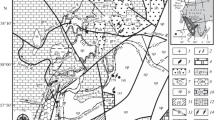Abstract
The BanskáŠtiavnica ore district is in the central zone of the largest stratovolcano in the Central Slovakia Neogene Volcanic Field, which is situated at the inner side of the Carpathian arc over the Hercynian basement with the Late Paleozoic and Mesozoic sedimentary cover. Volcanic rocks of the High-K orogenic suite are of the Badenian through Pannonian age (16.5–8.5 Ma). Their petrogenesis is closely related to subduction of flysch belt oceanic basement underneath the advancing Carpathian arc and to back-arc extension processes. The stratovolcano includes a large caldera 20 km in diameter and a late-stage resurgent horst in its centre, exposing a basement and extensive subvolcanic intrusive complex. The following stages have been recognized in the evolution of the stratovolcano: (1) formation of a large pyroxene/hornblende-pyroxene andesite stratovolcano; (2) denudation, emplacement of a diorite intrusion; (3) emplacement of a large granodiorite bell-jar pluton within the basement; (4) emplacement of granodiorite/quartz-diorite porphyry stocks and dyke clusters around the pluton; (5) caldera subsidence and its filling by biotite-hornblende andesite volcanics, emplacement of quartz-diorite porphyry sills and dykes at the subvolcanic level; (6) renewed activity of andesites from dispersed centres on slopes of the volcano; (7) uplift of a resurgent horst accompanied by rhyolite volcanics and granite porphyry dykes.
The following types of ore deposits (mineralizations) have been identified in the BanskáŠtiavnica ore district: 1. Quartz-pyrophyllite-pyrite high-sulphidation system at Šobov, related to the diorite intrusion. 2. Magnetite skarn deposits and occurrences at contacts of the granodiorite pluton with Mesozoic carbonate rocks. Magnetite ores occur as lenses in the calcic skarns. 3. Stockwork/disseminated base metal deposit along an irregular network of fractures in apical parts of the granodiorite pluton and in remnants of basement rocks. Mineral paragenesis is simple, with leading sphalerite and galena and minor chalcopyrite and pyrite. In overlying andesites the mineralization is accompanied by metasomatic quartzites and argillites with pyrophyllite, kaolinite, illite and pyrite. 4. Porphyry/skarn copper deposits and occurrences related to granodiorite/quartz-diorite porphyry dyke clusters and stocks around the granodiorite intrusion. The mineralized zone is represented by accumulations of chalcopyrite in exo- and endo-skarns, usually of the magnesian type affected by serpentinization. Besides chalcopyrite, pyrhotite, minor bornite, chalcosite, tennantite and magnetite, rare molybdenite and gold are present. The alteration pattern around productive intrusions includes an external zone of propylitization, a zone of argillitic alteration (kaolinite – illite – pyrite) and an internal zone of phyllic alteration (quartz – sericite – pyrite). Biotitization is rare and limited to porphyry intrusions. 5. Intrusion related “mesothermal” gold deposit in an andesitic environment just above the granodiorite intrusion. Gold of high fineness with base metal mineralization is contained in brecciated and/or banded quartz veins of subhorizontal orientation, parallel to the surface of granodiorite pluton. At least the first phase of mineralization is older than quartz-diorite porphyry sills, which separate granodiorite and blocks of mineralized andesite. 6. Hot spring type advanced argillic systems in the caldera filling. Silicites and opalites accompanied by kaolinite, alunite and pyrite grade downward into smectite dominated argillites. 7. Vein type epithermal precious/base metal deposits and occurrences as a result of the long lasting interaction among structural evolution of the resurgent horst and evolving hydrothermal system, extensive intrusive complex and deep seated siliceous magma chamber serving as heat and magmatic fluid source. Three types of epithermal veins occur in a zonal arrangement: (a) base metal veins ± Au with transition to Cu ± Bi mineralization at depth in the east/central part of the horst, (b) Ag – Au veins with minor base metal mineralization and (c) Au – Ag veins located at marginal faults of the horst. Isotopic composition of oxygen and hydrogen in hydrothermal fluids indicate mixing of magmatic and meteoric component (with generally increasing proportion of meteoric component towards younger mineralization periods?). Veins are accompanied by zones of silicification, adularization and sericitization, indicating a low sulphidation environment. 8. Replacement base metal mineralization of a limited extent in the Mesozoic carbonate rocks next to sulphide rich epithermal base metal veins.
Similar content being viewed by others
Author information
Authors and Affiliations
Additional information
Received: 28 September 1998 / Accepted: 5 February 1999
Rights and permissions
About this article
Cite this article
Lexa, J., Štohl, J. & Konečný, V. The BanskáŠtiavnica ore district: relationship between metallogenetic processes and the geological evolution of a stratovolcano. Mineral. Deposita 34, 639–654 (1999). https://doi.org/10.1007/s001260050225
Issue Date:
DOI: https://doi.org/10.1007/s001260050225



